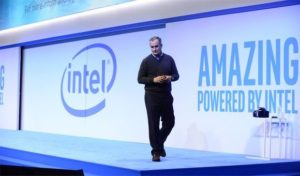Intel (NASDAQ: INTC) recently impressed investors with first quarter numbers that soundly beat analyst expectations. The chipmaker’s revenue rose 9% annually to $16.1 billion, topping estimates by $1.02 billion. Its non-GAAP earnings rose 32% to $0.87 per share, beating estimates by $0.15. It also capped off the report with rosy guidance that topped expectations on the top and bottom lines.
That marked an impressive comeback for the chipmaker, which struggled with slowing data center sales, rising competition in the x86 market, and the Spectre and Meltdown security debacles over the past year. But as we look into Intel’s future, we should also glance back at three major markets the chipmaker failed to crack over the past few years.

The wearables market
Back in 2013, Intel launched the New Devices Group, which mostly focused on wearable devices. In 2014 the unit acquired fitness watchmaker Basis Science. The following year, it acquired smart eyewear maker Recon Instruments and launched the Curie, a button-sized module it dubbed “the future of wearables.” It also installed its Atom chips, which were marginalized in the smartphone market, in smartwatches.
Unfortunately, Intel eventually lost that promising market to chip designs from SoftBank’s (NASDAQOTH: SFTBY) Arm Holdings, which now power 95% of the world’s wearable devices. Top ARM chipmakers like Qualcomm, riding high on ARM’s reputation for power-efficient designs in mobile devices, easily marginalized Intel’s chips.
Intel also reportedly refused to fund Recon’s plans to produce a new AR chip for its smart eyewear. Last year, Intel started cutting jobs at Recon, discontinued its Recon Jet smartglasses, and stopped producing the Curie module. Earlier this year the New Devices Group unveiled Vaunt, a pair of promising smartglasses that looked the same as regular glasses.

But in mid-April, Intel announced that it would close the New Devices Group, marking an abrupt and disappointing end to one of the chipmaker’s most innovative businesses.
IoT software
Back in 2009, Intel acquired Internet of Things (IoT) software maker Wind River Systems for $884 million. At the time, Intel declared that the purchase would give it “robust software capabilities in embedded systems and mobile devices.”
However, Intel eventually lost both markets to ARM licensees. Intel had sold its ARM chipmaking unit, Xscale, to Marvell Technology in 2006. It also refused to make processors for the first iPhone in 2007. The two moves sealed Intel’s fate in the mobile market, and that failure bled over to the embedded systems market. Last year, Intel discontinued its Edison, Galileo, and Joule IoT compute modules and boards.
In early April, Intel finally sold Wind River to private investment firm TPG for undisclosed terms. Intel stated that Wind River will remain “an important ecosystem partner” for its IoT group, but it’s likely that the unit simply couldn’t keep up with ARM’s own IoT software solutions.
Cybersecurity
In 2010, Intel acquired security software firm McAfee for $7.7 billion, and re-branded the unit as Intel Security. At the time, investors assumed that the company would integrate some of McAfee’s security features into its hardware.
That plan assumed that the PC market would keep growing. However, the PC market contracted, while the computing market expanded with smartphones, tablets, and other devices. Intel Security tried pivoting toward cloud security instead, but larger security software players were also making the same difficult transition.
Intel was lost in that shuffle, so it eventually sold a 51% stake in the security unit to TPG for $3.2 billion in 2016.
The key takeaway
Intel’s core business gradually improved over the past few years under Brian Krzanich, who took over as CEO in 2013. However, the company still remains behind the tech curve in many markets, and its attempts to catch up have often flopped.
This matters, because Intel is still branching off into adjacent markets like discrete GPUs and automotive chips. If it underestimates the competition or fails to foresee key market shifts, these new efforts could face the same fate as its past failures.


